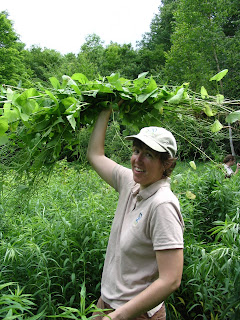This week marked the last week of LANDS for the summer! And what did that mean? Time to wrap our projects up! With that said, the last week was certainly a busy week but an exciting and eye-opening week, as well, as we had a chance to see our work come to fruition.
On Monday, we worked primarily on preparing ourselves for the week ahead. The team made further revisions on the report for the Dorset Park Natural Area and worked in smaller team groups on our individual STP projects with our respective land trusts.
Tuesday morning, we jumped in Jazzelle and headed off to the Vermont Youth Conservation Corp’s (VYCC) barn in Richmond. We worked with the VYCC earlier in the summer, where members of their crew helped teach us LANDS crewterns some basics of trail building hands-on. This time, we reversed roles and we were able to demonstrate to the VYCC crew at Richmond some of the things we do as a college conservation crew. We gave a brief introductory presentation on the meaning of conservation and the importance of maintaining proper habitat for species, in our case, we used the black bear as an example. We surveyed for potential bear habitat by measuring red oak, white oak, and beech trees and looked for any signs of bear that may have been present. We taught the crew how to identify the three types of trees, measure the trees at diameter at breast height, identify beech bark disease and beech scale, and fill out inventory forms. We even showed them how to use the GPS units to take waypoints. It was a great experience to be a part of such an educational exchange. Coming from very different backgrounds, it was a fantastic way to learn from one another and have a great time while doing so.
Once back from Richmond, we indulged in a delicious potluck lunch and then continued work on the report for Dorset Park in South Burlington as well as work on our small team projects with our respective land trusts.
That evening at 8:30 pm (just as the sun was setting and the bugs were growing blood-thirsty), our interns set out to Dorset park to meet up with Barry Genzlinger, a bat expert in his free time. We walked out to the stream running through the property on the edge of the forest and waited with bat echolocation devices to search for bats. We determined (through the pattern of sounds at specific frequencies transmitted over the device) that there were large brown bats on the property, and possibly hoary and silver-haired bats, as well. We really appreciated Gary taking time to come out with us and share his expertise.
On to Wednesday. We met up at the Greenhouse slightly later than normal and proceeded to Dorset Park to meet with Mike Snyder, the Chittenden County forester. This gave the crew a chance to ask Mike any last minute questions about management options for the property. We received a great deal of helpful advice which will undoubtedly strengthen our report that we hand over to the City of South Burlington at the culmination of our 9 weeks.
 Upon finishing at Dorset Park, it was back to the grind in the Greenhouse where we worked on the report some more and prepared for our presentation to South Burlington later that evening. After a dry run and some pizza from Leonardo’s on LANDS, we were off to present our findings and recommendations at the South Burlington town offices to roughly 20 South Burlington residents and users of the Dorset Park property. It was a great feeling to showcase what we have learned over the past weeks and to see such a great crowd of interested and involved citizens come together to see what we have done.
Upon finishing at Dorset Park, it was back to the grind in the Greenhouse where we worked on the report some more and prepared for our presentation to South Burlington later that evening. After a dry run and some pizza from Leonardo’s on LANDS, we were off to present our findings and recommendations at the South Burlington town offices to roughly 20 South Burlington residents and users of the Dorset Park property. It was a great feeling to showcase what we have learned over the past weeks and to see such a great crowd of interested and involved citizens come together to see what we have done.
Thursday and Friday were days spent working hard in the office to finish the remainder of our reports. On Thursday, the team headed to the GIS lab in the Aiken Center to digitize our polygons that we created for the wetland delineation in the Green Mountain National Forest. Together, we managed to piece together our work and it was truly impressive to see it come together so well. Friday was more or less the same, with the morning spent to complete our small team projects for our work with tree different land trusts in the area. In the afternoon, we worked on creating our final presentation.
We, LANDS, have had a truly eventful and exciting summer and we look forward to presenting our work on Monday at 6:30 pm in the Aiken Center, Room 105 at the University of Vermont! We welcome anyone to join and we recommend you arrive at 6:00 for some heavy refreshments and hors d'oeuvres! We look forward to seeing you there!





























 (Andrea L. hard at work filling out a data sheet on invasive species)
(Andrea L. hard at work filling out a data sheet on invasive species)
 (Andrea B. removing common buckthorn)
(Andrea B. removing common buckthorn) (The LANDS team working at Mt. Tabor)
(The LANDS team working at Mt. Tabor)



